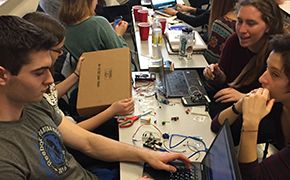Instructor Insights pages are part of the OCW Educator initiative, which seeks to enhance the value of OCW for educators.
Course Overview
This page focuses on the course RES.3-002 Collaborative Design and Creative Expression with Arduino Microcontrollers as it was taught by Kyle Keane and Andrew Ringler in IAP 2017.
This course was a 9-day hands-on workshop about collaboration, design, and electronics prototyping. Participants learned about microcontroller programming using Arduino, collaborative software development using GitHub, solderless electronics prototyping, electronic sensors, rapid prototyping, and small team management.
This course was offered during the Independent Activities Period (IAP), which is a special 4-week term at MIT that runs from the first week of January until the end of the month.
Course Outcomes
- Learn about microcontroller programming using Arduino
- Become familiar with collaborative software development using GitHub
- Explore solderless electronics prototyping
- Practice rapid prototyping
- Learn about small team management
On the first day of the workshop, we talk explicitly about how the point of being together in this shared space is for participants to find things that excite them, for them to share this excitement with others, and to feel vulnerable.
— Kyle Keane and Andrew Ringler
Below, Kyle Keane and Andrew Ringler describe various aspects of how they teach RES.3-002 Collaborative Design and Creative Expression with Arduino Microcontrollers.
The most exciting thing about this workshop is getting to be with a group of other students who are extremely creative and passionate about their interests.
— Ronit, MIT student
Below, two participants in RES.3-002 Collaborative Design and Creative Expression with Arduino Microcontrollers share their impressions of the workshop and offer advice to future participants.
Assessment
Grade Breakdown
There were no grades associated with this course.
Curriculum Information
Prerequisites
No previous experience with computer programming or videogame design required.
Requirements Satisfied
None
Offered
Offered periodically
Student Information

Breakdown by Year
52% undergraduates; 32% graduate students; 6% faculty and staff; 10% other
Breakdown by Major
Mostly material science, electrical engineering, and computer science
Typical Student Background
70% of participants came to the workshop with no previous Arduino programming experience; 18% had no previous computer programming experience; and 20% had no previous electronics experience.
During this nine-day workshop, students were expected to spend 27 hours in the class and optional project time out of the class, roughly divided as follows:
In Class
- Met 4–5 times per week for 3 hours per session; 9 sessions total.
- Workshop sessions were hands-on, with participants working in small teams to design and build electronics projects using open-source microprocessors.
Out of Class (Optional)
Some participants borrowed materials, such as sensors, to work on their projects outside of class.
Semester Breakdown
| WEEK | M | T | W | Th | F |
|---|---|---|---|---|---|
| 1 |  |  |  |  |  |
| 2 |  |  |  |  |  |
| 3 |  |  |  |  |  |
| 4 |  |  |  |  |  |
 No classes throughout MIT
No classes throughout MIT Workshop
Workshop No class session scheduled
No class session scheduled Public exhibition
Public exhibition

 Room 1 of 1
Room 1 of 1 